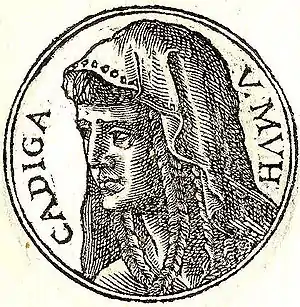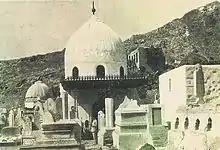Khadija bint Khuwaylid
Khadijah bint Khuwaylid (Arabic: خَدِيجَة بِنْت خُوَيْلِد, Khadījah bint Khuwaylid, born AD 555[1] – 22 November AD 619), commonly known as Khadija, was the first wife and first follower of the Islamic prophet Muhammad. Khadijah was the daughter of Khuwaylid ibn Asad, a leader of Quraysh tribe in Mecca, and a successful businesswoman in her own right.
Khadijah bint Khuwaylid Mother of the Believers | |
|---|---|
خَدِيجَة بِنْت خُوَيْلِد | |
 Calligraphic name of Khadijah | |
| Born | Khadījah bint Khuwaylid" AD 555[1] |
| Died | 10 Ramadan BH 3 in the ancient (intercalated) Arabic calendar[2] c. 619 (aged 63–64) Mecca, Hejaz, Arabia |
| Resting place | Jannat al-Mu'alla, Mecca |
| Other names | Khadījah al-Kubra |
| Title | ʾumm ul-mumineen |
| Spouse(s) | Hind Abi Hala Al-Tamimi (widowed) Atiq Al-Makhzumi (widowed) Muhammad |
| Children | |
| Parent(s) | Khuwaylid ibn Asad Fatimah bint Za'idah |
| Relatives | Son(s)-in-law: Uthman, Ali, Abu al-As ibn al-Rabi'
Grand son(s): Hasan ibn Ali, Husayn ibn Ali, Ali ibn Zainab Grand daughter(s): Umamah bint Zainab, Zaynab bint Ali, Umm Kulthum bint Ali |
| Family | Banu Asad (by birth) House of Muhammad (by marriage) |
Khadijah is often referred to by Muslims as "Mother of the Believers". She and her daughter Fatimah are two of the most important female figures in Islam. Muhammad was monogamously married to her for 25 years. The number of children she bore before and to Muhammad is disputed.
Before marrying Muhammad
Family
Khadijah's father, Khuwaylid ibn Asad, was a merchant[3] and leader. According to some/many traditions, he died c. AD 585 in the Sacrilegious War, but according to others, he was still alive when Khadijah married Muhammad in 595.[4][5] Khuwaylid also had a sister named Ume Habib binte Asad.[6]
Khadijah's mother, Fatima bint Za'idah, who died around AD 575,[7] was a member of the Amir ibn Luayy clan of the Quraysh[8] and a third cousin of Muhammad's mother.[9][10]
Profession
Khadijah became a very successful merchant. It is said that when the Quraysh's trade caravan travelers gathered to embark upon their summer journey to Syria or winter journey to Yemen, Khadijah's caravan equalled the caravans of all other traders of the Quraysh put together.[11] Honorifics associated with Khadijah included, “Ameerat-Quraysh (“Princess of Quraysh“),” “The Pious One,” and “Khadijah Al-Kubra (“Khadijah the Great”).”[12] It is said that she fed and clothed the poor, assisted her relatives financially and provided marriage portions for poor relations.[12] Khadijah was said to have neither believed in nor worshipped idols (Taghut), which was atypical for pre-Islamic Arabian culture.[13]
Khadijah did not travel with her trade caravans; she employed others to trade on her behalf for a commission. In 595 Khadijah needed a co-worker for a transaction in Syria. She chose Muhammad ibn Abdullah for the trade in Syria. With the permission of Abu Talib ibn Muttalib, his uncle, he was sent to Syria with one of Khadijah's servants. This caravan experience earned Muhammad the honorific titles “Al-Sadiq ("the Truthful")” and Al-Amin ("the Trustworthy" or "Honest").[14] Khadijah hired Muhammad, who was then 25 years old, sending word that she would pay double her usual commission.[15]
She sent one of her servants, Maysarah, to assist him. Upon returning, Maysarah gave accounts of the honorable way that Muhammad had conducted his business, with the result that he brought back twice as much profit as Khadijah had expected.[16]
Sunni version
Khadijah married three times and had children from all her marriages. While the order of her marriages is debated, it is generally believed that she first married Atiq ibn 'A'idh ibn' Abdullah Al-Makhzumi and second Malik ibn Nabash ibn Zargari ibn at-Tamimi.[17] To her second husband she bore two sons, who were named Hala and Hind.[18] He died before his business became a success.[19] To husband Atiq, Khadijah bore a daughter named Hindah. This marriage also left Khadijah as a widow.[20]
Khadijah proposed to Muhammad when he was 25 years old and she was 40 years old. Khadijah consulted her cousin Waraqah ibn Nawfal ibn Asad ibn 'Abdu'l-'Uzza.[16]
Shia version
Shi'a scholars believed Khadijah did not marry anyone before Muhammad.
Ibn Shahrashub quoted from al-Sayyid al-Murtada in al-Shafi and al-Shaykh al-Tusi in al-Talkhis that Khadijah was a virgin when she married Muhammad.[21] In addition, considering the cultural and intellectual situation in Hijaz and high position and status of Khadijah al-Kubra among other people, it would be highly improbable that she marry men from Banu Tamim and Banu Makhzum (the two “low” tribes).[22]
According to researchers, two children attributed to Khadijah were the children of Hala, Khadija's sister. After Hala’s husband’s death, Khadijah took care of Hala and (after Hala’s death) Hala’s children.[23]
Khadijah was 40 when she was married to Muhammad.[24][25][26][27]
However, some sources also claim that she was around the age of 25-28 or 30 by others. [28][29]
Marriage to Muhammad
Khadijah entrusted a friend named Nafisa to approach Muhammad and ask if he would consider marrying.[30] When Muhammad hesitated because he had no money to support a wife, Nafisa asked if he would consider marriage to a woman who had the means to provide for herself.[31] Muhammad agreed to meet with Khadijah, and after this meeting they consulted their respective uncles. The uncles agreed to the marriage, and Muhammad's uncles accompanied him to make a formal proposal to Khadijah.[16] It is disputed whether it was Hamza ibn Abdul-Muttalib, Abu Talib, or both who accompanied Muhammad on this errand.[20] Khadijah's uncle accepted the proposal, and the marriage took place. At the time of the marriage Muhammad was 25 years old and Khadijah was 40 years old.
Muhammad and Khadijah were married monogamously for 25 years. After her death, Muhammad took other wives.
Another Narration states Hisham bin Muhammad bin al-Sa’ib reports from his father Muhammad bin al-Sa’ib al-Kalbi from Abu Salih that Ibn ‘Abbas said: At the time of marriage with the Messenger of Allah, Khadija was twenty-eight years old.[32]
Children
Muhammad and Khadijah may have had six or eight children.[19] (Sources disagree about number of children: Al-Tabari names eight; the earliest biography of Muhammad, by Ibn Ishaq, names seven children; most sources only identify six).[17]
Their first son was Qasim, who died after his third birthday[33][34] (hence Muhammad's kunya Abu Qasim). Khadijah then gave birth to their daughters Zaynab, Ruqayyah, Umm Kulthum and Fatima; and lastly to their son Abd-Allah. Abd-Allah was known as at-Tayyib ("the Good") and at-Tahir ("the Pure") because he was born after Muhammad was declared a prophet by the Angel Gabriel as a direct message from Allah. Abdullah also died in childhood.[19]
Two other children also lived in Khadijah's household: Ali ibn Abi Talib, the son of Muhammad's uncle; and Zayd ibn Harithah, a boy from the Udhra tribe who had been kidnapped and sold into slavery. Zayd was a slave in Khadijah's household for several years, until his father came to Mecca to take him home. Muhammad insisted that Zayd be given a choice about where he lived, and Zayd decided to remain where he was, after which Muhammad legally adopted Zayd as his own son.[20]
Becoming the first follower of Muhammad

According to the traditional Sunni narrative, when Muhammad reported his first revelation from the Angel Gabriel (Jibril), Khadijah was the first person to accept Al-Haqq The Truth i.e. she accepted Islam.[35] After his experience in the cave of Hira, Muhammad returned home to Khadijah in a state of terror, pleading for her to cover him with a blanket. After calming down, he described the encounter to Khadijah, who comforted him with the words that Allah would surely protect him from any danger, and would never allow anyone to revile him as he was a man of peace and reconciliation and always extended the hand of friendship to all.[19] According to some sources, it was Khadijah's cousin, Waraka ibn Nawfal, who confirmed Muhammad's prophethood soon afterwards.[36]
Yahya ibn `Afeef is quoted saying that he once came, during the period of Jahiliyyah (before the advent of Islam), to Mecca to be hosted by 'Abbas ibn 'Abd al-Muttalib, one of Muhammad's uncles mentioned above. "When the sun started rising", he said, "I saw a man who came out of a place not far from us, faced the Kaaba and started performing his prayers. He hardly started before being joined by a young boy who stood on his right side, then by a woman who stood behind them. When he bowed down, the young boy and the woman bowed, and when he stood up straight, they, too, did likewise. When he prostrated, they, too, prostrated." He expressed his amazement at that, saying to Abbas: "This is quite strange, O Abbas!" "Is it, really?" retorted al-Abbas. "Do you know who he is?" Abbas asked his guest who answered in the negative. "He is Muhammad ibn Abdullah, my nephew. Do you know who the young boy is?" asked he again. "No, indeed," answered the guest. "He is Ali son of Abu Talib. Do you know who the woman is?" The answer came again in the negative, to which Abbas said, "She is Khadijah bint Khuwaylid, my nephew's wife." This incident is included in the books of both Ahmad ibn Hanbal and Al-Tirmidhi, each detailing it in his own Ṣaḥīḥ.
Khadijah was supportive of Muhammad's prophetic mission, always helping in his work, proclaiming his message and belittling any opposition to his prophecies.[35] It was her encouragement that helped Muhammad believe in his mission and spread Islam.[37] Khadijah also invested her wealth in the mission. When the polytheists and aristocrats of the Quraysh harassed the Muslims, she used her money to ransom Muslim slaves and feed the Muslim community.[38][39]
In 616 the Quraysh declared a trade boycott against the Hashim clan. They attacked, imprisoned and beat the Muslims, who sometimes went for days without food or drink.[40] Khadijah continued to maintain the community until the boycott was lifted in late 619 or early 620.[20]
Death

Khadijah died in "Ramadan of the year 10 after the Prophethood",[41] i.e., in November AD 619. Muhammad later called this tenth year "the Year of Sorrow", as his uncle and protector Abu Talib also died at this time.[42] Khadijah is said to have been about 65 years old at the time of her death.[43] She was buried in Jannat al-Mu'alla cemetery, in Mecca, Saudi Arabia.[44]
Another report Muhammad bin Ishaq said," Abu Talib and Khadija bint Khuwaylid died in the same year. This was three years before the emigration of the Messenger of Allah to Madina. Khadija was buried in al-Hajun. The Messenger of Allah buried her in her grave. She was 40 years old when the Messenger of Allah married her"[45]
In the years immediately following Khadijah's death, Muhammad faced persecution from opponents of his message and also from some who originally followed him but had now turned back. Hostile tribes ridiculed and stoned him.[46] Muhammad migrated to Yathrib (Medina) after Khadijah's death.
| Part of a series on Islam Shia Islam |
|---|
 |
|
|
Children and relatives
Sons
- Qasim ibn Muhammad, died in AD 601, after his third birthday
- Abd-Allah ibn Muhammad, died in childhood in AD 615
Daughters
- Fāṭimah al-Zahrā s.a bint Muhammad (605–632), although it is sometimes asserted that she was born during the first year of Muhammad's mission (610–611). She had the by-name "The mother of her father", as she took over caring for her father and being a support to her father once her mother died.[47] She married Ali, who became the fourth caliph in 656. (According to early debate after the death of Muhammad, some would argue that Ali would be the proper succession to Muhammad.)[48] Ali and Fatimah moved to a small village in Ghoba after the marriage, but later moved back to Medina to live next door to Muhammad.[49] Muhammad forbade Ali to take additional wives because, "What caused pain to his daughter grieved him as well."[50] Fatima died six months after her father died. All of Muhammad's surviving descendants are by Fatima's children. Muhammad loved her two sons Hassan and Husayn, who would continue his heritage.[50]
- Zaynab (599–629). She married her maternal cousin Abu al-Aas ibn al-Rabee before al-Hijra.[19] Later lived with Muhammad. Her husband accepted Islam before her death in 629
- Ruqayyah (601–624). She was first married to Utbah ibn Abu Lahab and then to the future third caliph Uthman ibn Affan.[19]
- Umm Kulthum (603–630). She was first married to Utaybah bin Abu Lahab and then, after the death of her sister Ruqayyah, to Uthman ibn Affan. She was childless.
Sunni view
The Sunni scholar Yusuf ibn abd al-Barr says: "His children born of Khadīja are four daughters; there is no difference of opinion about that."[51]
"O Prophet! Say to your azwaj (Arabic: أزواج, wives) and your banat (Arabic: بـنـات, daughters) and the nisa’il-mu’minin (Arabic: نـسـاءِ الـمـؤمـنـيـن, "women of the believers") ..."
Shia view
According to some Shi‘ite sources, Khadijah and Muhammad together had only one biological daughter, Fatimah. The others either belonged to Khadijah's sister or were from a previous marriage and were treated by Muhammad as his own daughters. The Shi'i scholar Abu'l-Qasim al-Kufi writes:
When the Messenger of Allah married Khadijah, then some time thereafter Halah died leaving two daughters, one named Zaynab and the other named Ruqayyah and both of them were brought up by Muhammad and Khadijah and they maintained them, and it was the custom before Islam that a child was assigned to whoever brought him up.[53]
- Hind bint Atiq. She married her paternal cousin, Sayfi ibn Umayya, and they had one son, Muhammad ibn Sayfi.[54][55]
- Zaynab bint Abi Hala, who probably died in infancy.[56]
The adopted daughters attributed to Muhammad, by Shia sources, are:
- Zaynab (599–629). She married her maternal cousin Abu al-Aas ibn al-Rabee before al-Hijra.[19] Later lived with Muhammad. Her husband accepted Islam before her death in 629
- Ruqayyah (601–624). She was first married to Utbah ibn Abu Lahab and then to the future third caliph Uthman ibn Affan.[19]
- Umm Kulthum (603–630). She was first married to Utaybah bin Abu Lahab and then, after the death of her sister Ruqayyah, to Uthman ibn Affan. She was childless.[19][57]
Cousins
- Abd-Allah ibn Umm-Maktum
- Waraqah ibn Nawfal was the son of Nawfal b. Asad b. ʿAbd al-ʿUzzā b. Ḳuṣayy and Hind bt. Abī Kat̲h̲īr. Waraqah had been proposed to marry Khadijah bint Khuwaylid, but the marriage never took place. Waraqah is noteworthy because he converted from polytheism to Christianity before Muhammad's revelation.[58] Ibn Ishaq claims that Waraqah is also important because he plays a role in legitimizing Muhammad's revelation.
"There has come to him,” Waraḳa says, “the greatest law that came to Moses; surely he is the prophet of this people”[59]
See also
Her important descendants
References
- Cheema, Waqar Akbar (4 December 2017). "The Age of Khadija at the Time of her Marriage with the Prophet: Abstract". Archived from the original on 15 April 2019. Retrieved 15 April 2019.
- Sayyid Ali Ashgar Razwy. "The Birth of Muhammad and the Early Years of his Life". Archived from the original on 10 October 2017. Retrieved 7 November 2017.
- Benedikt, Koehler (2014). Early Islam and the Birth of Capitalism. Lexington Books.
- Guillaume. The Life of Muhammad. Oxford. p. 83.
- Muhammad ibn Saad, Tabaqat vol. 1. Translated by Haq, S. M. Ibn Sa'd's Kitab al-Tabaqat al-Kabir, pp. 148–149. Delhi: Kitab Bhavan.
- Muhammad ibn Saad, Tabaqat vol. 1. Translated by Haq, S. M. Ibn Sa'd's Kitab al-Tabaqat al-Kabir, p. 54. Delhi: Kitab Bhavan.
- Hendrix, Scott E.; Okeja, Uchenna (2018). The World's Greatest Religious Leaders: How Religious Figures Helped Shape World History. ABC-CLIO. p. 452. ISBN 9781440841385. Retrieved 16 April 2019.
- "Chapter 2: Early Life". Al-Islam.org.
- Haq, S.M. Ibn Sa'd's Kitab al-Tabaqat al-Kabir, vol. 1. p. 54.
- The Women of Madina. Ta-Ha Publishers. p. 9.
- Muhammad ibn Saad, Tabaqat vol. 8. Translated by Bewley, A. (1995). The Women of Madina, p. 10. London: Ta-Ha Publishers.
- van Gorder, A Christian (2014). Islam, Peace and Social Justice: A Christian Perspective. Cambridge. p. 162. ISBN 978-0-227-17422-7. Archived from the original on 2018-02-17. Retrieved 2017-12-29.
- Yasin T. al-Jibouri. "Khadijah, Daughter of Khuwaylid, Wife of Prophet Muhammad". Ahlul Bayt Digital Islamic Library Project. Archived from the original on 2 February 2017. Retrieved 23 August 2017. "One particular quality in Khadijah was quite interesting, probably more so than any of her other qualities mentioned above: She, unlike her people, never believed in nor worshipped idols."
- Martin Lings, Muhammad: His Life Based on the Earliest Sources, p. 33–34.
- Muhammad ibn Saad, Tabaqat vol. 1. Translated by Haq, S. M. Ibn Sa'ad's Kitab al-Tabaqat al-Kabir, p. 145–146. Delhi: Kitab Bhavan.
- Guillaume (1955). The Life of Muhammad. Oxford.
- al-Tabari (trans. Ismail K Poona Walla) (1990). Volume 9: The Last Years of the Prophet (PDF). State University of New York Press. ISBN 0-88706-691-7. Archived (PDF) from the original on 2020-02-06. Retrieved 2020-03-18.
- Watt, Montgomery W. (2012). "Khadija". In P. Bearman; et al. (eds.). Encyclopaedia of Islam (Second ed.). Archived from the original on 26 June 2018. Retrieved 7 April 2019. (First print edition: ISBN 9789004161214, 1960-2007).
- "Khadijah bint Khuwaylid". Islam's Women. Archived from the original on 18 March 2019.
- "Khadija bint Khuwaylid". Tree of Faith. Archived from the original on 2012-04-07.
- Ibn Shahrashub. Manaqib Al Abi Talib. pp. Vol. 1, P. 159.
- Amili. Al Sahih Min Sirat Al Nabi. pp. Vol. 2, P. 123.
- Amili. Al Sahih Min Sirat Al Nabi. pp. Vol. 2, P. 125.
- Amili. Al Sahih Min Sirat Al Nabi. pp. Vol. 2, P. 114.
- Ibn Ishaq. Mustadrak Al Hakim. pp. 3. p. 182.
- Ibn Saad. Al Tabaqat Al Kubra.
- Abo Abdullah Al Hakim. Al Mustadarak.
- Ibn Saad. Al Tabaqat Al Kubra. pp. Vol.8 page 13.
- Al-Hakim Abu‘Abdullah. al-Mustadrak. pp. Vol.3, 200 No. 4837.
- Lings (1983). Muhammad: His Life Based on the Earliest iiiiSources. New York: Inner Traditions Internationalist. p. 83.
- Lings (1983). Muhammad: His Life Based on the Earliest Sources. Inner Traditions Internationalist.
- Muhammad, Ibn Sa’d. Tabaqat al-Kubra. pp. Vol.8, 13.
- Barboza, Gileno. "Qasim ibn Muhammad". Geneanet. Retrieved 18 March 2020.
- As-Sallaabee, Dr 'Ali Muhammad (trans. Faisal Shafeeq (2001). The noble life of the Prophet (PDF). 1. p. 107. Archived (PDF) from the original on 2015-03-25. Retrieved 2020-03-18.
- Guillaume. The Life of Muhammad. Oxford. p. 111.
- Al-Jibouri, Yasin T (2020). "Khadijah, Daughter of Khuwaylid, Wife of Prophet Muhammad". Ahlul Bayt Digital Islamic Library Project. Archived from the original on 24 April 2019. Retrieved 18 March 2020.
- Abbott, Nabia (1942). "Women and the State in Early Islam". Journal of Near Eastern Studies. The University of Chicago Press. 1 (1): 106–109. doi:10.1086/370632. JSTOR 542352. S2CID 162188874.
- "The Economic and Social Boycott of the Banu Hashim". Al-Islam.org. Archived from the original on 2010-01-09. Retrieved 2009-09-09.
- "The Deaths of Khadija and Abu Talib". Al-Islam.org. Archived from the original on 2010-01-09. Retrieved 2009-09-09.
- Guillaume. The Life of Muhammad. Oxford. p. 143.
- Tabari, Tarikh al-Rusul wa'l-Muluk. Translated by Landau-Tasseron, E. (1998). Vol. 39, Biographies of the Prophet's Companions and Their Successors, p. 161. New York: SUNY Press.
- Guillaume. The Life of Muhammad. Oxford. p. 191.
- "Chapter 12: The Death". Al-Islam.org. Archived from the original on 2011-06-10. Retrieved 2009-09-09.
- Muhammad, Farkhanda Noor.Islamiat for Students Archived 2009-03-15 at the Wayback Machine. Revised Edition 2000: pp. 74–75.
- Al-Hakim, Abu ‘Abdullah. al-Mustadrak. pp. Vol.3, 200 No. 4837.
- Qasimi, Ja'Far (1987). The Life, Traditions, and Sayings of the Prophet. New York: Crossroad. pp. 77–78.
- Shariati, Ali (1981). Ali Shariati's Fatima Is Fatima. Tehran, Iran: Shariati Foundation.
- Madelung, Wilferd (1997). The Succession to Muhammad. Cambridge University Press. pp. 52–53.
- Shariati, Ali (1981). Ali Shariati's Fatima is Fatima. Tehran, Iran: Shariati Foundation. p. 148.
- Walther, Wiebke (1993). Women in Islam. Markus Wiener Publishing Princeton & New York. p. 108.
- al-Istī`āb fī Ma`rifat al-Aşĥāb Yusuf ibn abd al-Barr, The Comprehensive Compilation of the Names of the Prophet's Companions vol. 1, p. 50.
- Quran 33:59
- al-Istighathah, p. 69.
- Muhammad ibn Saad, Tabaqat vol. 8. Translated by Bewley, A. (1995). The Women of Madina p. 9. London: Ta-Ha Publishers.
- Tabari, Tarik al-Rusul wa'l-Muluk. Translated by Landau-Tasseron, E. (1998). Biographies of the Prophet's Companions and Their Successors vol. 39 p. 161. New York: SUNY Press.
- Guillaume. The Life of Muhammad. Oxford. p. 792.
- Buhl. "UmmKulthum". Archived from the original on 2014-05-29. Retrieved 2012-04-23.
- Robinson, C. F. (2012). Encyclopedia of Islam, Second Edition. ISBN 9789004161214. Retrieved 25 April 2017.
- Ishaq, Ibn (2001). The Life of Muhammad (Reprint ed.). Karachi ; New York: Oxford University Press. ISBN 0196360331.
Further reading
- The True Mother of Believers – Hazrat Khadijah (s.a.) (Serat Online)
- Hazrat Khadijah RA (Ummahatul Mumineen)
- The Prophet's (PBUH) Marriage to Khadijah (Ahmed El-Kadi)
- "Wife of the Prophet Muhammad". Archived from the original on October 14, 2007.
- "Our Lady Khadijah bint Khuwaylid". Islamic House of Wisdom. Ann Arbor, Mich. 31 December 2012.